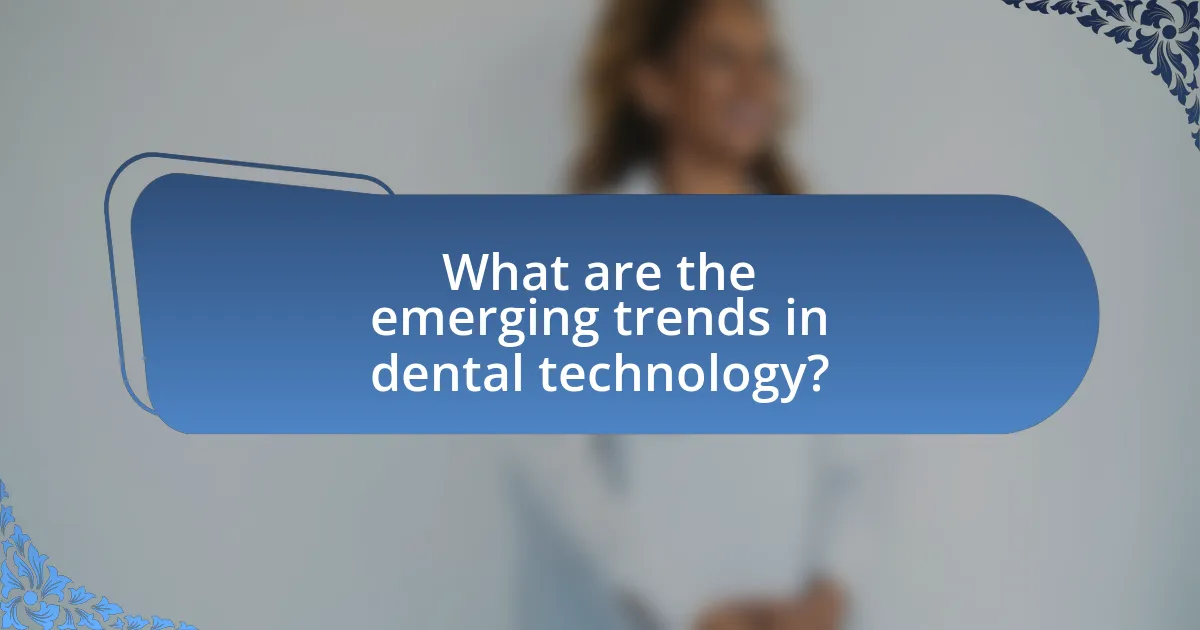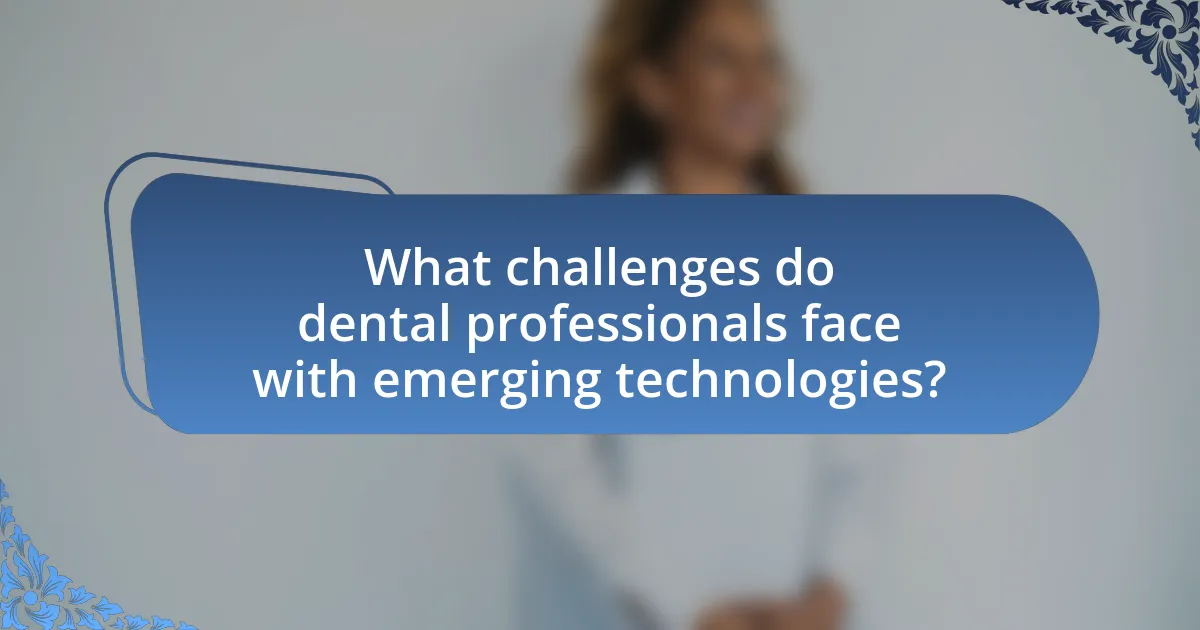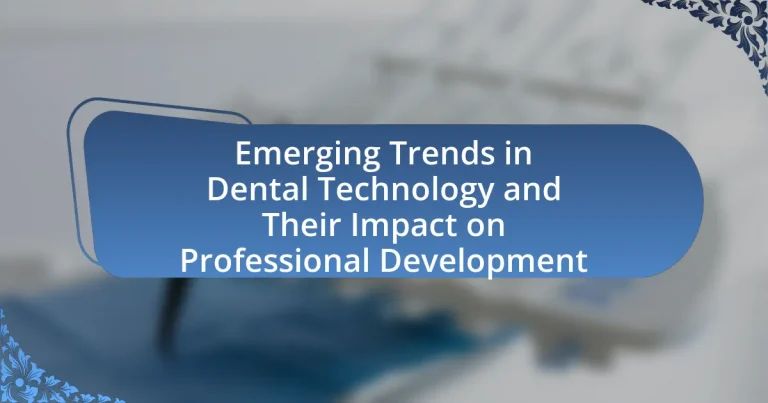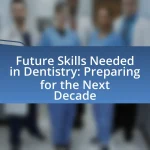The article focuses on emerging trends in dental technology and their impact on professional development within the field. Key advancements include the integration of artificial intelligence, teledentistry, 3D printing, and digital dentistry, which enhance diagnostic accuracy, treatment efficiency, and patient engagement. The article also discusses how these technologies necessitate ongoing education and training for dental professionals, highlighting the importance of adapting to new tools and techniques to improve patient outcomes and streamline practice operations. Additionally, it addresses the challenges faced by dental practitioners in adopting these technologies, such as financial constraints and resistance to change, while offering strategies for successful integration and collaboration among professionals.

What are the emerging trends in dental technology?
Emerging trends in dental technology include the integration of artificial intelligence, teledentistry, 3D printing, and digital dentistry. Artificial intelligence is being utilized for diagnostics and treatment planning, enhancing accuracy and efficiency in patient care. Teledentistry allows for remote consultations, expanding access to dental services, particularly in underserved areas. 3D printing is revolutionizing the production of dental prosthetics and orthodontic devices, reducing costs and turnaround times. Digital dentistry, encompassing CAD/CAM systems, streamlines workflows and improves precision in restorations. These trends are reshaping the dental landscape, promoting innovation and improving patient outcomes.
How are advancements in digital dentistry shaping the field?
Advancements in digital dentistry are significantly shaping the field by enhancing precision, efficiency, and patient outcomes. Technologies such as 3D printing, intraoral scanning, and computer-aided design/computer-aided manufacturing (CAD/CAM) streamline workflows, reduce treatment times, and improve the accuracy of dental restorations. For instance, a study published in the Journal of Prosthetic Dentistry found that CAD/CAM systems can reduce the time required for producing dental crowns from several weeks to just a few hours, thereby increasing patient satisfaction and practice productivity. Additionally, digital imaging techniques provide clearer diagnostics, enabling more effective treatment planning and better communication with patients. These advancements not only improve clinical practices but also necessitate ongoing professional development for dental practitioners to stay current with evolving technologies.
What technologies are leading the digital transformation in dentistry?
The technologies leading the digital transformation in dentistry include CAD/CAM systems, 3D printing, digital imaging, and tele-dentistry. CAD/CAM systems enable precise design and manufacturing of dental restorations, significantly reducing turnaround times and improving accuracy. 3D printing allows for the rapid production of dental models and prosthetics, enhancing customization and efficiency. Digital imaging technologies, such as cone beam computed tomography (CBCT), provide detailed visualizations that improve diagnosis and treatment planning. Tele-dentistry facilitates remote consultations, expanding access to dental care. These technologies collectively enhance patient outcomes and streamline dental practices, as evidenced by studies showing increased efficiency and patient satisfaction in practices that adopt these innovations.
How do these technologies improve patient outcomes?
Emerging dental technologies improve patient outcomes by enhancing diagnostic accuracy, treatment efficiency, and patient engagement. For instance, digital imaging techniques, such as cone beam computed tomography (CBCT), provide detailed 3D images that allow for precise diagnosis and treatment planning, reducing the likelihood of complications. Additionally, advancements in laser dentistry enable minimally invasive procedures, which lead to quicker recovery times and less discomfort for patients. Studies have shown that the use of these technologies can increase patient satisfaction rates, as they often result in shorter treatment times and improved overall experiences in dental care settings.
What role does artificial intelligence play in dental practices?
Artificial intelligence plays a significant role in dental practices by enhancing diagnostic accuracy, streamlining administrative tasks, and improving patient care. AI algorithms analyze dental images, such as X-rays, to detect cavities, periodontal disease, and other conditions with high precision, often outperforming human radiologists. For instance, a study published in the Journal of Dental Research found that AI systems achieved an accuracy rate of over 95% in identifying dental caries compared to traditional methods. Additionally, AI-driven software automates appointment scheduling and patient management, reducing administrative burdens and allowing dental professionals to focus more on patient care. This integration of AI not only improves operational efficiency but also elevates the overall quality of dental services provided.
How is AI being integrated into diagnostic processes?
AI is being integrated into diagnostic processes by utilizing machine learning algorithms to analyze medical images and patient data for more accurate diagnoses. For instance, AI systems can detect dental caries and periodontal diseases through image recognition, significantly improving diagnostic accuracy and speed. Studies have shown that AI can achieve diagnostic performance comparable to or exceeding that of human experts, with some algorithms demonstrating over 90% accuracy in identifying specific conditions. This integration not only enhances the precision of diagnoses but also streamlines workflows in clinical settings, allowing dental professionals to focus more on patient care.
What are the implications of AI for treatment planning?
AI significantly enhances treatment planning by enabling personalized and data-driven approaches in dental care. It analyzes vast amounts of patient data, including medical history and imaging, to recommend tailored treatment options. For instance, a study published in the Journal of Dental Research found that AI algorithms can predict treatment outcomes with over 90% accuracy, improving decision-making for clinicians. Additionally, AI streamlines workflows by automating routine tasks, allowing dental professionals to focus more on patient care. This integration of AI not only increases efficiency but also elevates the standard of care provided to patients.
How is tele-dentistry changing patient care?
Tele-dentistry is transforming patient care by providing remote access to dental consultations and services, which enhances convenience and accessibility for patients. This innovation allows patients to receive timely advice, diagnosis, and treatment plans without the need for in-person visits, thereby reducing travel time and associated costs. According to a study published in the Journal of Telemedicine and Telecare, tele-dentistry has been shown to increase patient engagement and satisfaction, with 85% of patients reporting a positive experience. Furthermore, it enables dental professionals to monitor patients’ oral health remotely, facilitating early intervention and improving overall treatment outcomes.
What are the benefits of remote consultations for patients?
Remote consultations provide patients with increased accessibility to healthcare services, allowing them to receive care from the comfort of their homes. This convenience reduces travel time and associated costs, making it easier for patients with mobility issues or those living in remote areas to access dental care. Additionally, remote consultations can lead to quicker diagnosis and treatment, as patients can connect with healthcare providers without the delays often associated with in-person visits. Studies indicate that telehealth services can improve patient satisfaction and adherence to treatment plans, as they offer flexible scheduling options that accommodate patients’ busy lives.
How does tele-dentistry affect the dentist-patient relationship?
Tele-dentistry enhances the dentist-patient relationship by increasing accessibility and convenience for patients. This technology allows patients to consult with dentists remotely, reducing barriers such as travel time and scheduling conflicts. A study published in the Journal of Telemedicine and Telecare found that 70% of patients reported higher satisfaction with their dental care when using tele-dentistry services, indicating that remote consultations can foster a more positive relationship. Additionally, tele-dentistry facilitates better communication, as patients can easily share concerns and receive timely advice, further strengthening the bond between dentists and their patients.

What is the impact of these trends on professional development in dentistry?
Emerging trends in dental technology significantly enhance professional development in dentistry by facilitating continuous learning and skill advancement. For instance, the integration of digital tools such as 3D printing and tele-dentistry requires dental professionals to acquire new competencies, thereby promoting ongoing education and training. According to a study published in the Journal of Dental Education, 85% of dental professionals reported that advancements in technology motivated them to pursue additional training and certifications. This trend not only improves clinical skills but also enhances patient care, as practitioners become adept at utilizing the latest technologies to provide more efficient and effective treatments.
How are dental professionals adapting to new technologies?
Dental professionals are adapting to new technologies by integrating digital tools such as CAD/CAM systems, 3D printing, and tele-dentistry into their practices. These technologies enhance precision in procedures, streamline workflows, and improve patient engagement. For instance, a study published in the Journal of Dental Research found that the use of CAD/CAM technology can reduce the time required for restorations by up to 50%, demonstrating significant efficiency gains. Additionally, tele-dentistry allows for remote consultations, expanding access to care, particularly in underserved areas. This adaptation not only improves clinical outcomes but also supports ongoing professional development through training in advanced technological skills.
What training is required for dentists to stay current with technology?
Dentists are required to engage in continuing education and specialized training programs to stay current with technology. These programs often include courses on the latest dental software, digital imaging techniques, and advancements in dental materials and equipment. For instance, the American Dental Association (ADA) recommends that dentists complete a minimum of 15 hours of continuing education annually, which can include topics such as CAD/CAM technology and laser dentistry. This ongoing education ensures that dental professionals remain knowledgeable about emerging technologies and can effectively integrate them into their practice.
How do continuing education programs address emerging trends?
Continuing education programs address emerging trends in dental technology by offering updated curricula that reflect the latest advancements and practices in the field. These programs incorporate new technologies, such as digital dentistry and telehealth, ensuring that dental professionals remain competitive and knowledgeable. For instance, the American Dental Association (ADA) provides resources and courses that focus on innovations like 3D printing and artificial intelligence in dentistry, which are increasingly relevant in modern practice. By aligning educational content with current industry developments, these programs facilitate the ongoing professional growth of dental practitioners, enabling them to adapt to changes and improve patient care.
What skills are becoming essential for modern dental practitioners?
Modern dental practitioners are increasingly required to possess skills in digital dentistry, patient communication, and data management. Digital dentistry skills include proficiency in CAD/CAM technology and 3D printing, which enhance treatment precision and efficiency. Effective patient communication is essential for building trust and ensuring patient compliance, particularly as treatment options become more complex. Additionally, data management skills are crucial for utilizing electronic health records and leveraging patient data analytics to improve care outcomes. These skills align with the ongoing integration of technology in dental practices, reflecting the industry’s shift towards more advanced, patient-centered care.
How does proficiency in technology enhance career prospects?
Proficiency in technology significantly enhances career prospects by increasing employability and enabling professionals to adapt to industry advancements. In the dental field, for instance, familiarity with digital tools such as CAD/CAM systems, 3D printing, and tele-dentistry allows practitioners to improve patient care and streamline workflows. According to a study published in the Journal of Dental Education, dental professionals who embrace technological advancements are more likely to secure higher-paying positions and experience career growth, as 75% of employers prioritize candidates with strong tech skills. This trend underscores the importance of continuous learning and adaptation to new technologies in maintaining a competitive edge in the job market.
What soft skills are important in a tech-driven dental environment?
In a tech-driven dental environment, important soft skills include communication, adaptability, teamwork, and problem-solving. Effective communication is essential for conveying complex information about dental technologies to patients and colleagues. Adaptability is crucial as dental professionals must quickly learn and integrate new technologies into their practice. Teamwork is vital for collaborating with diverse healthcare teams, ensuring seamless patient care. Problem-solving skills enable professionals to address challenges that arise from the use of advanced dental technologies. These soft skills enhance the overall efficiency and effectiveness of dental practices in a rapidly evolving technological landscape.
How do these trends influence the future of dental education?
Emerging trends in dental technology significantly influence the future of dental education by necessitating the integration of advanced digital tools and techniques into curricula. As technologies such as teledentistry, 3D printing, and artificial intelligence become more prevalent, dental education programs must adapt to equip students with the skills needed to utilize these innovations effectively. For instance, a study published in the Journal of Dental Education highlights that incorporating digital dentistry into training enhances students’ readiness for modern practice, reflecting the industry’s shift towards technology-driven patient care. This adaptation ensures that future dental professionals are not only proficient in traditional methods but also adept at leveraging new technologies to improve patient outcomes and streamline practice operations.
What changes are being made to dental school curricula?
Dental school curricula are increasingly incorporating advanced technologies and interdisciplinary approaches to better prepare students for modern dental practice. These changes include the integration of digital dentistry tools, such as CAD/CAM systems and 3D printing, which enhance students’ technical skills and understanding of contemporary treatment modalities. Additionally, curricula are emphasizing the importance of interprofessional education, allowing dental students to collaborate with other healthcare disciplines, thereby fostering a more holistic approach to patient care. Evidence of these shifts can be seen in recent studies, such as the American Dental Education Association’s report, which highlights the necessity for dental programs to adapt to technological advancements and evolving patient needs.
How are mentorship programs evolving in response to technology?
Mentorship programs are evolving by integrating digital platforms and tools to enhance accessibility and engagement. These programs now utilize video conferencing, online forums, and mobile applications, allowing mentors and mentees to connect regardless of geographical barriers. For instance, a study by the American Dental Association found that 70% of dental professionals prefer virtual mentorship options due to their flexibility and convenience. Additionally, data analytics are being employed to tailor mentorship experiences based on individual needs and progress, making the process more personalized and effective.

What challenges do dental professionals face with emerging technologies?
Dental professionals face several challenges with emerging technologies, including high costs, the need for continuous education, and integration into existing workflows. High costs associated with advanced dental technologies, such as 3D printing and digital imaging systems, can be prohibitive for many practices, limiting access to these innovations. Additionally, the rapid pace of technological advancement necessitates ongoing training and education for dental professionals to stay current, which can be time-consuming and resource-intensive. Furthermore, integrating new technologies into established workflows often requires significant adjustments, leading to potential disruptions in practice efficiency. These challenges highlight the complexities dental professionals must navigate to effectively adopt and utilize emerging technologies in their practices.
What are the barriers to adopting new dental technologies?
The barriers to adopting new dental technologies include high costs, lack of training, resistance to change, and insufficient evidence of effectiveness. High costs deter many dental practices from investing in advanced technologies, as initial expenses can be significant. Lack of training prevents dental professionals from effectively utilizing new tools, leading to underutilization. Resistance to change stems from established practices and skepticism about new methods, which can hinder the integration of innovative technologies. Additionally, insufficient evidence of effectiveness makes practitioners hesitant to adopt technologies that lack robust clinical validation, impacting their willingness to change established workflows.
How do financial constraints impact technology implementation?
Financial constraints significantly hinder technology implementation by limiting the resources available for investment in new systems and tools. Organizations facing budget restrictions often prioritize essential expenditures, which can delay or prevent the adoption of advanced technologies. For instance, a study published in the Journal of Dental Research found that dental practices with limited financial resources were less likely to invest in digital imaging technologies, which are crucial for improving diagnostic accuracy and patient outcomes. This lack of investment can lead to outdated practices, reduced competitiveness, and ultimately, a negative impact on professional development within the field.
What role does resistance to change play in technology adoption?
Resistance to change significantly hinders technology adoption by creating barriers to the acceptance and integration of new tools and practices. When dental professionals exhibit reluctance to embrace emerging technologies, it can lead to slower implementation rates, decreased efficiency, and missed opportunities for improved patient care. Research indicates that approximately 70% of change initiatives fail due to employee resistance, highlighting the critical need for effective change management strategies in the dental field. Addressing concerns through training, communication, and support can mitigate resistance, facilitating smoother transitions to new technologies and enhancing overall professional development.
How can dental professionals overcome these challenges?
Dental professionals can overcome challenges related to emerging trends in dental technology by actively engaging in continuous education and training programs. These programs equip them with the necessary skills to adapt to new technologies, such as digital imaging and tele-dentistry, which are increasingly becoming standard in practice. Research indicates that ongoing professional development significantly enhances practitioners’ confidence and competence in utilizing advanced technologies, thereby improving patient outcomes and practice efficiency. For instance, a study published in the Journal of Dental Education found that dental professionals who participated in technology-focused training reported a 30% increase in their ability to integrate new tools into their practice effectively.
What strategies can be employed to facilitate technology integration?
To facilitate technology integration in dental practices, strategies such as providing comprehensive training, fostering a culture of innovation, and ensuring ongoing technical support are essential. Comprehensive training equips dental professionals with the necessary skills to effectively use new technologies, which has been shown to increase adoption rates and improve patient outcomes. Fostering a culture of innovation encourages staff to embrace new tools and techniques, leading to enhanced practice efficiency and patient care. Additionally, ongoing technical support ensures that practitioners can troubleshoot issues and maximize the benefits of technology, as evidenced by studies indicating that practices with robust support systems experience higher satisfaction and lower resistance to change.
How can collaboration among professionals enhance technology use?
Collaboration among professionals enhances technology use by fostering knowledge sharing and innovation. When dental professionals work together, they can exchange insights on the latest technological advancements, leading to improved implementation and utilization of these tools. For instance, a study published in the Journal of Dental Research found that interdisciplinary collaboration in dental practices resulted in a 30% increase in the adoption of digital technologies, such as CAD/CAM systems. This collaborative environment not only accelerates the learning curve for new technologies but also encourages the development of best practices, ultimately improving patient outcomes and operational efficiency.
What best practices should dental professionals follow when adopting new technologies?
Dental professionals should prioritize thorough training and education when adopting new technologies. This ensures that they are proficient in using the technology effectively, which can enhance patient care and operational efficiency. Research indicates that practices that invest in comprehensive training programs experience a 30% increase in productivity and a 25% improvement in patient satisfaction scores. Additionally, dental professionals should evaluate the technology’s evidence-based benefits, ensuring it aligns with best practices and enhances clinical outcomes. Regularly seeking feedback from staff and patients about the technology’s performance can also guide future technology adoption decisions.
How can ongoing education and training be effectively implemented?
Ongoing education and training can be effectively implemented through structured programs that incorporate both theoretical knowledge and practical skills relevant to emerging trends in dental technology. These programs should include a blend of online courses, hands-on workshops, and mentorship opportunities to ensure comprehensive learning. For instance, the American Dental Association emphasizes the importance of continuous professional development, stating that dental professionals who engage in ongoing education are better equipped to adopt new technologies and improve patient care. Additionally, utilizing platforms that offer real-time feedback and assessments can enhance the learning experience, ensuring that practitioners stay updated with the latest advancements in the field.
What resources are available for staying updated on dental technology trends?
To stay updated on dental technology trends, professionals can utilize several key resources. Industry journals such as the Journal of Dental Research and the Journal of the American Dental Association publish peer-reviewed articles on the latest advancements. Additionally, attending dental conferences like the Greater New York Dental Meeting and the Chicago Dental Society Midwinter Meeting provides firsthand exposure to emerging technologies and networking opportunities. Online platforms such as DentalTown and the American Dental Association’s website offer forums and articles that discuss current trends and innovations. Furthermore, subscribing to newsletters from dental technology companies and organizations ensures regular updates on new products and research findings. These resources collectively provide comprehensive insights into the evolving landscape of dental technology.


